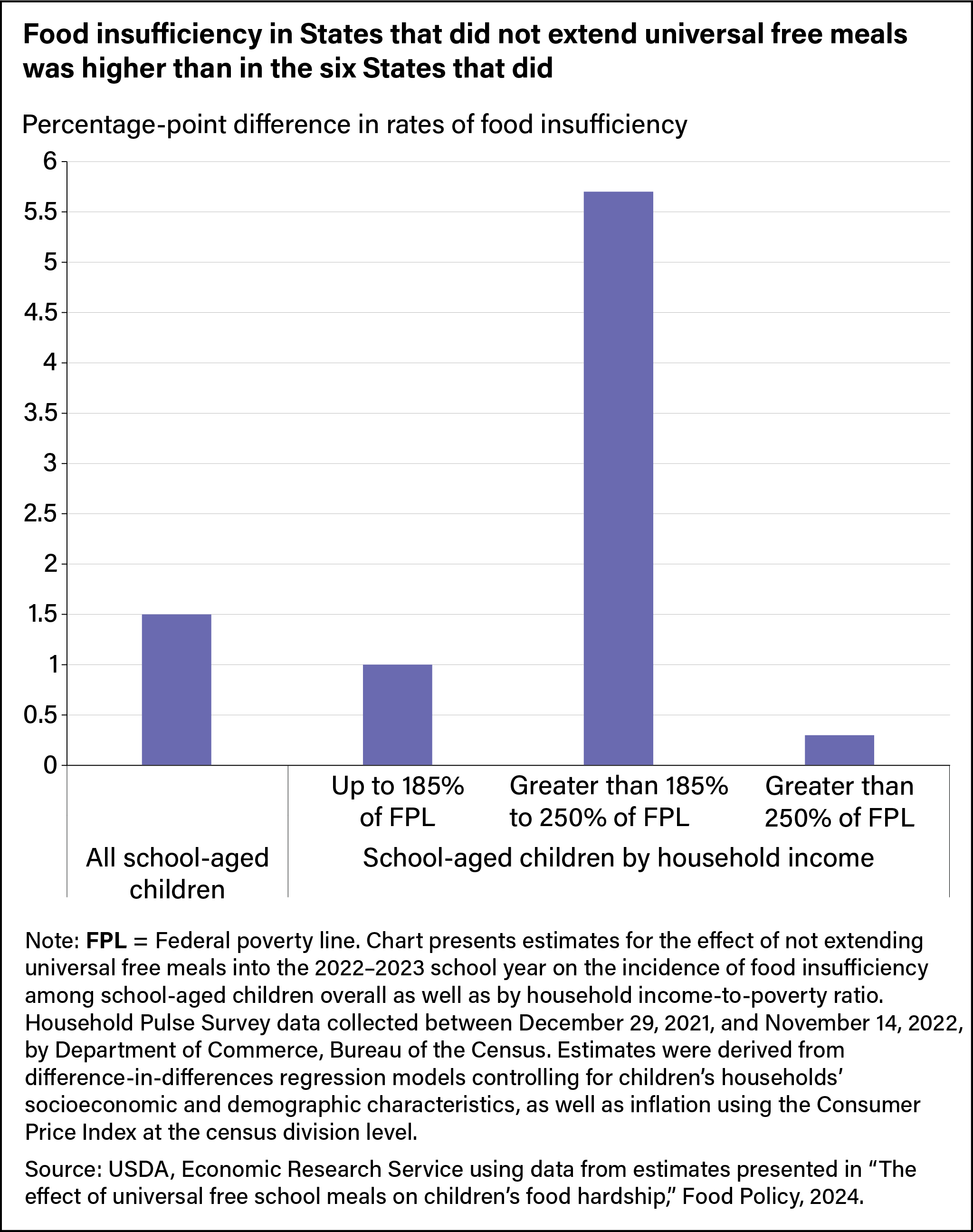
State Universal Free School Meal Policies Reduced Food Insufficiency Among Children in the 2022–2023 School Year
- by Saied Toossi
- 6/13/2024
The National School Lunch Program and School Breakfast Program provide nutritious meals to tens of millions of children each school day. Typically, children receive federally subsidized meals through these programs for free if their household’s income is no more than 130 percent of the Federal poverty line and at a reduced-price if their household’s income is greater than 130 percent and up to 185 percent of the Federal poverty line. All other children pay full price. In response to the onset of the Coronavirus (COVID-19) pandemic in March 2020, the Federal Government issued a waiver allowing schools to serve free meals to all children, a policy colloquially referred to as “universal free meals.” This waiver expired in June 2022, and schools were once again required to charge some students for school meals beginning with the 2022–2023 school year. However, six States (California, Connecticut, Maine, Massachusetts, Nevada, and Vermont) opted to supplement Federal funding for the school meal programs with State funds to extend universal free meals into the school year.
A researcher at USDA, Economic Research Service recently used data from the Household Pulse Survey collected from December 29, 2021, through November 14, 2022, to investigate the relationship between State universal free meals policies and children’s food hardship. More specifically, the study compared rates of food insufficiency—defined as sometimes or often not having enough to eat—among school-aged children (ages 5–17) in States that did not extend universal free meals into the 2022–2023 school year to those in States that did in the periods before and after these policies went into effect.
The study examined this relationship among school-aged children overall, as well as by their household incomes. School-aged children were categorized into three categories:
- those in households with incomes up to 185 percent of the Federal poverty line and therefore eligible for free or reduced-price school meals regardless of whether States opted to extend universal free meals.
- those in households with incomes from 185 percent to 250 percent of the Federal poverty line.
- those from households with incomes greater than 250 percent of the Federal poverty line.
Although all children from households with incomes greater than 185 percent of the Federal poverty line are charged full price for school meals absent universal free meals, households with incomes from 185 percent to 250 percent of the Federal poverty line may face greater financial hardship than those with incomes above 250 percent of the Federal poverty line and may therefore be more likely to be impacted by State universal free meal policies.
The study found that the incidence of food insufficiency among school-aged children was 1.5 percentage points higher in States that did not extend universal free meals into the 2022–2023 school year compared with the incidence among those in States that did in the period after the Federal Government’s waiver expired. Compared with the average food insufficiency rate of 15.3 percent in the period before State universal free meal policies went into effect, the 1.5 percentage point difference represents a 9.8-percent increase in the food insufficiency rate. Additionally, the study found this result was driven by school-aged children in households with incomes just above the eligibility threshold for free and reduced-price school meals. Among this group, the incidence of food insufficiency was 5.7 percentage points higher. Universal free meals may impact children in this population more as their households’ incomes may make them ineligible to receive aid through other food and nutrition assistance programs, such as USDA’s Supplemental Nutrition Assistance Program.
Since November 2022, more States have adopted universal free meals statewide, and others are considering legislation to do the same.
This article is drawn from:
- Toossi, S. (2024). The effect of universal free school meals on children’s food hardship. Food Policy. Volume 124 https://doi.org/10.1016/j.foodpol.2024.102606 Available for open access through the USDA, National Agricultural Library..
You may also like:
- Toossi, S. (2023, September 20). One-Third of Households With Children Paying for School Meals Reported That Doing So Contributed to Financial Hardship. Amber Waves, U.S. Department of Agriculture, Economic Research Service.
- Child Nutrition Programs - National School Lunch Program. (n.d.). U.S. Department of Agriculture, Economic Research Service.
- Food Security in the United States. (n.d.). U.S. Department of Agriculture, Economic Research Service.
- Child Nutrition Programs - School Breakfast Program. (n.d.). U.S. Department of Agriculture, Economic Research Service.
- Child Nutrition Programs. (n.d.). U.S. Department of Agriculture, Economic Research Service.
- Jones, J.W. & Toossi, S. (2024). The Food and Nutrition Assistance Landscape: Fiscal Year 2023 Annual Report. U.S. Department of Agriculture, Economic Research Service. EIB-274.
- Toossi, S. & Jones, J.W. (2023). The Food and Nutrition Assistance Landscape: Fiscal Year 2022 Annual Report. U.S. Department of Agriculture, Economic Research Service. EIB-255.
- Toossi, S. (2023). Cost of School Meals and Households’ Difficulty Paying for Expenses: Evidence From the Household Pulse Survey. U.S. Department of Agriculture, Economic Research Service. EB-37.


